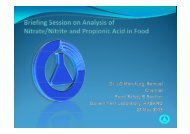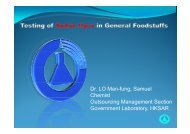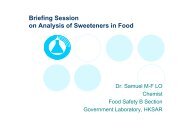食物中二氧化硫分析簡介 - uri=govtlab.gov
食物中二氧化硫分析簡介 - uri=govtlab.gov
食物中二氧化硫分析簡介 - uri=govtlab.gov
Create successful ePaper yourself
Turn your PDF publications into a flip-book with our unique Google optimized e-Paper software.
Briefing Session on Analysis<br />
of Sulphur Dioxide in Food<br />
Dr. Jasmine LAU Po-kwan<br />
Chemist<br />
Food Safety B Section<br />
Government Laboratory, HKSAR
Background<br />
Contents<br />
Testing Methods<br />
Findings in 2007<br />
Proficiency Tests
Cap 132BD<br />
Background<br />
Preservatives in Food Regulations<br />
食物內防腐劑規例<br />
Preservatives: any substance which is capable of<br />
inhibiting, retarding or arresting the process of<br />
fermentation, acidification or other deterioration of food of<br />
masking any of the putrefaction.<br />
防腐劑: 指任何能抑制、減慢或遏止食物的發酵、發酸或其<br />
他變壞過程或能掩蓋食物腐爛徵狀的物質。
FOOD WHICH MAY CONTAIN PRESERVATIVE AND THE NATURE<br />
AND PROPORTION OF PRESERVATIVE IN EACH CASE<br />
可含防腐劑的食品及每種食品可含防腐劑的性質及分量<br />
Specified food 指明食物 Permitted preservatives<br />
Fruit juice, sweetened or unsweetened<br />
whether concentrated not<br />
加糖或不加糖的果汁(不論是否濃縮)<br />
Pickles, other than pickled olives<br />
醃製食品,醃製橄<br />
欖除外<br />
Dessert, fruit based milk and cream<br />
甜品及以水果拌製 的奶類及忌廉<br />
准許防腐劑<br />
Sulphur dioxide 二氧化硫 350<br />
Sulphur dioxide 二氧化硫 100<br />
Sulphur dioxide 二氧化硫 100<br />
Parts per million not<br />
exceeding<br />
含量不得超逾 的百萬分率
Cap 132W<br />
Background<br />
Food and Drugs (Composition and Labelling)<br />
Regulations<br />
食物及藥物(成分組合及標籤)規例<br />
If a food consists of or contains sulphite in a concentration<br />
of 10 parts per million or more, the functional class of the<br />
sulphite and its name shall be specified in the list of<br />
ingredients. (L.N. 85 of 2004)<br />
如食物由濃度達到或超過百萬分之十的亞硫酸鹽組成或含有<br />
上述濃度的亞硫酸鹽,有關的亞硫酸鹽的作用類別及其名稱<br />
須在配料表中指明。 (2004年第85號法律公告)
Background – Food categories<br />
for the analysis of Sulphur Dioxide<br />
Range of food samples<br />
Beverage (soft drinks, juices,<br />
coffee…)<br />
Pickles or preserved<br />
food( prune, plum..)<br />
Fruits (orange, snow pear,<br />
lemon, watermelon….)<br />
Sauce (oyster sauces, soya<br />
sauce, salad dressing…)<br />
Meat (beef, lamp chop, pork…)<br />
Etc……
Testing Method: International Standard Methods<br />
AOAC 975.32 Sulphurous acid in Food Qualitative Test<br />
AOAC 961.09 Sulphites in Meats Qualitative Test<br />
AOAC 990.28 Sulphites in Food Optimized Monier-<br />
Williams Method<br />
AOAC 990.29 Sulphite (Total) in Foods and<br />
Beverages<br />
ISO 5522:1981 Sulphur dioxide in Fruits,<br />
Vegetables and derived products<br />
ISO 5523:1981 Sulphur dioxide in Liquid fruit and<br />
vegetable products<br />
Flow Injection<br />
Analysis Method<br />
Titration Method<br />
Iodometric titration
Testing Method:<br />
Methods used by the Government Laboratory<br />
i) Qualitative Test for Sulphurous Acid in Food using<br />
AOAC method 975.32<br />
ii) Qualitative Test for Sulphurous Acid in Meat using<br />
AOAC method 961.09<br />
iii) Determination of Sulphur Dioxide by Optimized<br />
Monier-Williams Method similar to AOAC 990.28<br />
iv) Determination of Sulphur Dioxide by Flow Injection<br />
Analysis similar to AOAC 990.29
Qualitative Test for Sulphurous Acid in Food<br />
Comminute and homogenise the samples<br />
Place ~25g well blended sample in a 200 mL Erlenmeyer flask.<br />
Add a small amount of zinc dust and about 3 mL conc. HCl.<br />
Place a moisten lead acetate paper on the mouth of the flask.<br />
Positive results are indicated by<br />
blackening of the lead acetate paper
Standards at diff. conc. level<br />
Screening results of the Qualitative Test<br />
0 ppm<br />
8 ppm<br />
50 ppm<br />
Blank samples spiked at diff. conc. level<br />
0 ppm<br />
8 ppm<br />
50 ppm<br />
Examples of blank samples spiked at diff. conc. level
Qualitative Test for Sulphurous Acid in Meat<br />
Comminute and homogenise the samples<br />
Transfer ~3.5 g ground meat to an impervious white surface<br />
Add 0.5 mL malachite green solution to the sample and mix vigorously<br />
with a spatula<br />
Observe the colour after a few mins<br />
Malachite green solution: Dissolve 200 mg<br />
malachite green in water and dilute to 1 L
Screening results of the Qualitative Test<br />
Standards at diff. conc. level<br />
50 ppm<br />
8 ppm<br />
0 ppm<br />
Blank samples spiked with diff. conc. level<br />
50 ppm<br />
8 ppm<br />
0 ppm<br />
Malachite green is<br />
decolourised in the<br />
presence of sulphites<br />
Normal meat becomes<br />
blue-green
Determination of Sulphur Dioxide<br />
by Optimized Monier-Williams Method<br />
Homogenise the whole submitted sample thoroughly<br />
Weigh accurately 25g sample into a three necked 1L round<br />
bottomed flask<br />
Add about 400 mL water-ethanol mixture (95:5 v/v) to the flask<br />
with further addition of 2 drops of anti-foaming agent for carrying<br />
out the distillation<br />
For dried herbal or dehydrated sample,<br />
soak the homogenised sample with the<br />
ethanol-water for 1 hour prior the<br />
analysis
Connect a gas inlet tube for the introduction of N 2<br />
Add 30 mL 3% H 2 O 2 solution to a collection vessel and add a few drop of<br />
methyl red to the solution for trapping the distillate (SO 2 )<br />
Add HCl into flask and start heating the solution for about 100 minutes<br />
Collect the distillate for titration analysis<br />
The introduction of a steady N 2 flow is<br />
important!
Determination of Sulphur Dioxide by Titration<br />
Titrate the distillate with pre-standardised 0.01M NaOH solution to the<br />
yellow point of methyl red<br />
Record the volume of NaOH used
Determination of Sulphur Dioxide content by<br />
barium sulphate gravimetric method<br />
Add 5 mL 10% BaCl 2 solution to the titrated content of the vessel<br />
Filter the white precipitate<br />
Dry the filter at 105 to 110°C and weight the resulted barium<br />
sulphate
Determination of Sulphur Dioxide<br />
in Food by Flow Injection Analysis<br />
Comminute and homogenise the samples<br />
Weigh 10g sample in 50 mL centrifuge tube<br />
Add 30-50 mL TCM extraction solution<br />
~ 2 mL Carrez solutions to the centrifuge tube<br />
(solid and semi-solid sample only)<br />
• Shake and sonicate for ~10 mins respectively<br />
Sodium tetrachloromercurate (TCM) extraction solution, 0.04M Hg:<br />
Dissolve 4.70g NaCl, 10.90 HgCl 2 and 6.80g KH 2 PO 4 in 1L Milli-Q water<br />
Carrez Solution 1: 10.6 g potassium ferrocyanide (II) (K 4 [Fe(CN) 6 ].3H 2 O) in 100 mL<br />
distilled water<br />
Carrez Solution 2: 22.0 g zinc acetate and 3 mL glacial acetic acid in distilled water<br />
and dilute to 100 mL
Centrifuge the sample at 2000 r.p.m. for 10 mins<br />
Filter the extract of the test sample<br />
Repeat the extraction process twice<br />
Centrifuge the solution at 2000 r.p.m. for 10 mins before injecting the<br />
solution into the flow inject analyser (FIA)<br />
•Sample size may be deducted according to the<br />
nature of the food type<br />
•Dilution of the extract may be needed for samples<br />
with suspected high concentration<br />
•The method is not applicable to any dehydrated<br />
samples
• Pump speed: 25 s<br />
• Cycle period: 200 s<br />
Setup of the Flow Injection Analysis<br />
• Injection of sulphuric acid is suggested<br />
between samples injections
FIA spectrum of sulphur dioxide<br />
•The degree of decoloration of the malchite<br />
green is ∝ the amount of sulphite in the<br />
sample solution
Reporting Limits<br />
Quantitation of SO 2:<br />
8 mg/kg<br />
PCB
Total samples: 2,075<br />
No. of positive samples: 180<br />
Findings in 2007<br />
Types of samples No. of<br />
Positive samples<br />
Concentration range found<br />
Cakes, bread 2 21 ppm to 150 ppm<br />
Meat products, fresh, frozen 45 10 ppm to 5,500 ppm<br />
Preserved fruits and<br />
vegetables<br />
125 10 ppm to 9,500 ppm<br />
Sauces 1 52 ppm<br />
Seeds, nuts and their<br />
products<br />
1 15 ppm<br />
Sugar confectionery 6 10 ppm to 1,000 ppm
• Identification and assay<br />
determination<br />
• Reference Procedures<br />
can be obtained from<br />
Food Chemcials Codex<br />
JECFA specification<br />
Standards Validation<br />
http://www.fao.org/ag/agn/jecfa-additives/search.html?lang=en
FAPAS<br />
Proficiency Test<br />
http://www.fapas.com<br />
Proficiency Test Start Date Matrix Analytes<br />
T2740 31/10/2008 Jam -sulphites<br />
T2055 07/08/2008 Meat -sulphur dioxide
Proficiency Test<br />
LGC Standards Proficiency Testing Group<br />
http://www.lgcpt.com/<br />
QBS<br />
QUALITY IN BEVERAGES SCHEME Scheme<br />
•Next Dispatch Date will be on 02 Sept 2008<br />
QFCS<br />
QUALITY IN FOOD CHEMISTRY SCHEME<br />
•3 distributions per annum<br />
•Next Dispatch Date will be on 29 July 2008<br />
SODAS<br />
SOFT DRINKS PROFICIENCY TESTING SCHEME<br />
•Scheme operates from October to September each year and test materials are<br />
distributed quarterly .<br />
•Next Dispatch Date will be on 07 Apr 2008
THANK YOU





